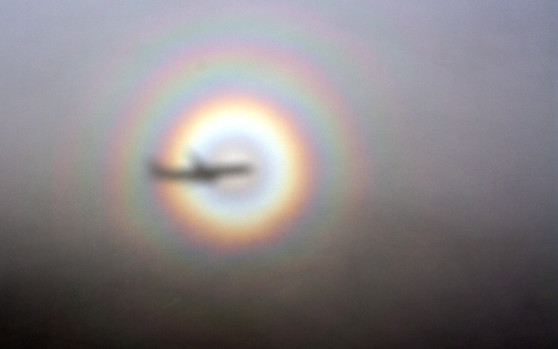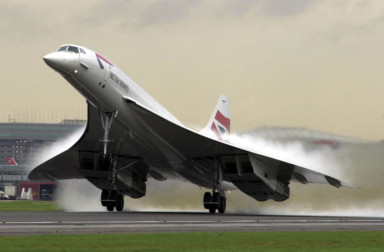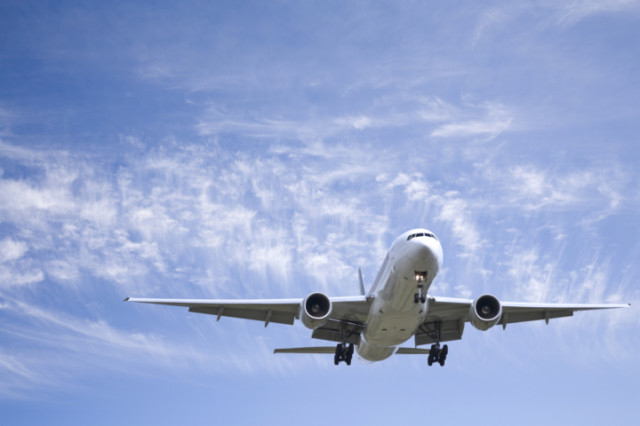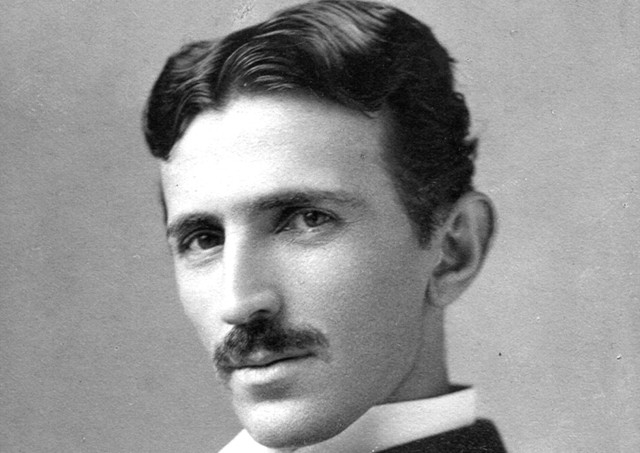
1. The wing myth
For many years we taught the wrong explanation for the way wings keep aircraft in the air. It was thought that the wing shape meant that air has further to travel over the top surface than the bottom, making the air above move faster to keep up, reducing pressure and producing lift. This “Bernoulli effect” does exist, but almost all a aeroplane’s lift comes from Newton’s third law of motion. The wing is shaped to push air downwards. As the air is pushed down, the wing gets an equal and opposite push upwards, lifting the aircraft.
2. Forget electric aircraft
When we see ultra-light experimental electric aircraft it is easy to assume there will soon be clean, green, electric airliners — it is even suggested by a category in the Longitude Prize 2014 — but it won’t happen any time soon. Aircraft fuel packs in a remarkable amount of energy — 15 times the amount per kilogram as TNT (the explosive simply burns faster). Batteries are much less efficient. To provide the same energy as a tonne of fuel would take 100 tonnes of batteries — and a 747 uses 150 to 200 tonnes of fuel. Unless battery technology is made vastly more efficient, electric airliners won’t get off the ground.
3. Death rays to radar
Radar is essential for flight, in ground and air traffic control, plus on-board weather detection. A contraction of “range and direction finding”, radar was developed by the Radio Research Station in Slough before the Second World War. According to legend, researchers were asked to look into claims that the eccentric inventor Nikola Tesla had developed a death ray that used electromagnetic radiation. Though the scientists found radio waves ineffective as weapons, they did discover that reflections of a radio signal with wavelengths of a few centimetres detected aircraft far beyond the range of optical spotters.
4. Gasholder navigation
Modern aircraft use GPS (Global Positioning System) satellite navigation much as cars do, and also have radio beacons called VOR (VHF Omnidirectional Radio Range) to guide them into airports. But in the early days of civil aviation, basic landmarks were often used. A large gasholder was a good visual guide into Heathrow but unfortunately an identical structure was located near RAF Northolt, resulting in an American 707 landing there by accident. The Heathrow gasholder, visible from the main line out of Paddington as it passes through Southall, still bears the letters LH, painted on it after the incident.
5. Einstein’s satnav
The GPS system is essential for modern aviation, but this ubiquitous technology would go wrong if it weren’t corrected for relativity. Einstein’s theory has two parts. Special relativity, dealing with the effects of motion, says that time on a moving object runs slowly when seen from elsewhere. A GPS satellite is a very accurate clock broadcasting a time signal, which slows because of its motion as seen from the ground. However, general relativity, which covers gravity, says that a gravitational field also slows time down. As a satellite experiences weaker gravity than on Earth, a satellite’s clock runs quicker. This effect is bigger than that of special relativity. If not corrected for relativity, GPS would drift by several kilometres a day.
6. Beware the vortex
Pilots prefer a rolling start, where the aircraft accelerates immediately as it turns on to the runway, but in practice they often wait a long time to get clearance. This is to allow the air to settle after a previous take-off, as an aeroplane’s wingtips generate vortices in the air, which can take two or three minutes to disperse. If the following aircraft set off immediately, the rapidly moving air would make the aircraft difficult to handle, so the delay gives the air time to recover from the miniature whirlwinds caused by the preceding aeroplane.
7. Passing clouds
One of the pleasures of flying is seeing clouds close up. Even though they seem insubstantial, they carry a considerable weight of water — around 500 tonnes in a small cumulus cloud. And water is denser than air. So it is reasonable to ask why clouds don’t fall out of the sky like rain. They do. But the cloud’s droplets are much closer to the size of air molecules than a raindrop, and are buoyed up by the constant battering of those energetic gas molecules. As a result, the droplets take a long time to sink. An average cloud would take a year to fall one metre.
8. On cloud nine
Most of us are happy to label clouds “fluffy ones”, or “nasty black ones”, but meteorologists identify more than 50 cloud types based on shape and altitude. These fit into categories established in 1896, given numbers one to nine. Cloud nine was the vast, towering cumulonimbus, so to be “on cloud nine” implied being on top of the world. However, meteorology doesn’t stand still and a cloud 10 was added, ruining the turn of phrase. With unusual sensitivity, the World Meteorological Organisation later renumbered the system, making categories run from zero to nine, restoring cloud 9 to its former glory.
9. Around the rainbow
There’s no better place to see a rainbow than from an aeroplane. Rainbows are produced when sunlight hits raindrops, is split into rainbow colours by refraction, then reflects off the back of the drop to return towards your eye, an effect requiring the angle between the incoming light and that heading for your eye to be about 42 degrees. We see a bow because the Earth gets in the way, but from an aircraft, a rainbow is a complete circle. When passing over clouds, the aircraft’s shadow appears neatly in the centre of the effect.
10. Mr blue sky
In Victorian times, the blue sky was thought to be an effect of dust particles, but it is air molecules that are responsible. Sunlight is white, containing all the colours of the spectrum, but as it passes through air some of the light is scattered when it interacts with the gas molecules. Blue light scatters more than the lower energy colours, so the blue appears to come from the sky, leaving a yellower light coming directly from the sun. When Concorde flew, the sky appeared much darker outside as it cruised half as high again as aircraft today, where thinner air produces less scattering.
11. There’s life out there
Apart from clouds and other aircraft we don’t expect to see much directly outside a flying aircraft’s window, but the air is seething with bacterial life — as many as 1,800 different types of bacteria have been detected over cities, and they can reach twice the cruising height of a aeroplane. The record holder for a larger organism is a vulture called a Ruppell’s griffon, discovered the hard way at around 38,000 feet when the three-metre-wingspan bird was sucked into an aircraft engine.
12. Turbulence terror
Even the most experienced flyer can be turned green by turbulence, caused by air currents flowing between regions of temperature differential, or by wind shear, where two sections of air move in different directions. The outcome can be anything from repeated bumping to sudden, dramatic plunges. The good news for nervous flyers is that no modern airliner has ever been brought down by turbulence. People have been injured and occasionally killed when they are not strapped in and hit the ceiling, or get struck by poorly secured luggage — but the aircraft is not going to be knocked out of the sky.
13. In-flight radiation
When body scanners were introduced at airports there were radiation scares, but the level produced is the same as passengers receive in one minute of flight. The Earth is constantly bombarded by cosmic rays, natural radiation from space that has more impact at altitude. Exposure to such radioactivity is measured in milliSieverts (mSv). The average background radiation on the ground in the UK is around 2.5mSv a year, rising to 7 or 8mSv in areas like Cornwall. If you fly 10 hours a week, it adds 4mSv to your exposure — no more than moving from London to Cornwall.
14. You can’t cure jet lag
The world is arbitrarily divided into time zones (some very arbitrarily — Venezuela, for example, is 4 hours behind GMT, while Nepal is 5 hours ahead). The result is that long-haul travel results in a difference between local time and your body’s time, causing jet lag. This is no more an illness than being tired, so can’t be “cured”. However, its effects can be minimised by keeping food bland for 24 hours before travel, drinking plenty of fluids and living on your destination time from the moment you reach the aircraft.
15. Supersonic 747s
Since the demise of Concorde, we can’t book a supersonic flight — yet many of us have travelled faster than sound. There are a number of jet streams in the upper atmosphere, notably on the journey from the US to Europe, where a temperature inversion causes a corridor of air to move as fast as 402kmph with respect to the ground. If an airliner with an airspeed of 885kmph enters a jet stream (as they do on the eastbound Atlantic crossing), the result can be to fly at 1,287kmph with respect to the ground, above sound’s 1,190kmph.
16. Flying through time
Time zones provide an artificial journey through time — but special relativity means that a flight involves actual time travel. This effect plays a part in any journey. Because you are moving with respect to the Earth, your time runs slightly slower compared with Earth time, which means that at the end of a journey, returning to Earth you have moved very slightly into the future. The effect is tiny unless your velocity is close to the speed of light, so crossing the Atlantic weekly for 40 years would only move you 1/1,000th of a second into the future.
17. Terrible tea
Don’t blame the cabin attendant if your Earl Grey isn’t great. Tea enthusiasts tell us that the water should be just under 100C when it is poured on to tea leaves — but that isn’t possible on an aeroplane. In flight, the cabin is kept at the equivalent pressure of 8,000 feet above sea level, and the lower the pressure, the lower the temperature at which water boils. It’s impossible to get water beyond 90C during flight — so choose coffee. (Outside the aircraft at 12,000 metres, the tea would be even worse as the water boils at 53C.)
18. I can’t hear my food
Airline food has a reputation for being bland and tasteless. Some of the problem may not be poor catering, though. An aircraft is a noisy environment. We usually filter the background noise out after a while, but it is still there. And there is evidence that food loses some of its savour when we are exposed to loud noises. (The research to date is limited, so more data is needed to be sure.) With a loud background noise, people seem to consider their food more crunchy but lacking key flavours. Perhaps we should get ear defenders on the tray.
19. Needle in a haystack
With modern technology it seems strange that Malaysian flight MH370 could disappear without trace — yet finding a missing aircraft is a needle-in-a-haystack problem. The aeroplane knows its location, both from GPS and inertial tracking, but this information is not relayed elsewhere in real time. That would be perfectly possible, just as commercial vehicle tracking is available on land. Ocean-going ships have had tracking since the 1980s — the limitation is not technology, but a lack of legislation requiring it. The other problem would be preventing the system from being switched off, which for now has to be possible as a fire prevention precaution.
20. Volcanic fallout
Air travel can be summarily cancelled by volcanic activity, as in 2010 when Eyjafjallajökull brought European flights to a standstill. There was much complaint, but there was a real danger. In 1982, BA Flight 9 from London to Auckland had all four engines stopped by an ash cloud over West Java. It was only after 12 minutes and a drop of 25,000 feet that the engines were restarted. Glass-like ash particles melt in the heat of the engine, then solidify on the rotors. A clear-skies policy in an ash cloud may be inconvenient — but the risks of ignoring the ash are clear.
21. The doors aren’t locked
Some people think that, as on trains, the doors are locked on departure. You may hear a command to the cabin crew along the lines of, “Doors to automatic. Cross check”, which sounds as if the doors are being locked. In fact this instruction is to put the inflatable evacuation slides on to automatic, so they shoot out if the door is opened. In practice the doors on an aeroplane don’t need to be locked. If you watch an aircraft door being opened, it swings in an unusual way. It first has to be opened inwards before manoeuvring it out of the way. Once the aircraft has taken off, a significant pressure difference soon builds up between the inside of the aircraft and the outside, as the cabin pressure becomes higher than the rapidly falling outside pressure. This differential forces the door into place. To open it you would have to pull against the air pressure, well beyond the capabilities of human muscles.
Brian Clegg is author of “Inflight Science: A Guide to the World from Your Airplane Window”. His most recent book is “The Quantum Age”
–Guardian News & Media Ltd














